Workday Training in New York City, New York, USA
Workday Time Tracking Tutorial.
Workday Time Tracking is an indispensable way of efficiently overseeing employee schedules. Are you curious to discover its capabilities for use within your organisation? Here, we delve into the details of its configuration.
Once inside a tenant, one of the first things you will notice is various patterns for Workday Time Tracking. This helps outline when employees should work, making scheduling seamless and structured.
Workday Time Tracking makes setting up patterns easy; all it requires to create them is selecting a date – let’s say we need to implement a new work pattern starting Monday, for instance – clicking the plus icon, configuring working dates, and specifying start time.
Workday Time Tracking for Shift Workers
Have you ever considered how many patterns a shift worker could need in Workday Time Tracking? Depending on the worker type, patterns can differ widely depending on what kind of shift worker schedule needs tracking.
Suppose you’re attending the Workday Time Tracking Tutorial in New York City, New York, USA.
In that case, you’ll see firsthand how the system makes it easier to effectively define and monitor these patterns for workers who follow unique working schedules, such as weekends or specific shifts.
Identify these unique work patterns through Workday Time Tracking to manage them more effectively.
Patterns may be straightforward for salaried employees who typically follow one that corresponds with their grade or workgroup.
However, contractors and other specific groups require greater flexibility, as Workday Time Tracking gives you access to various rules that enable flexible adaptation.
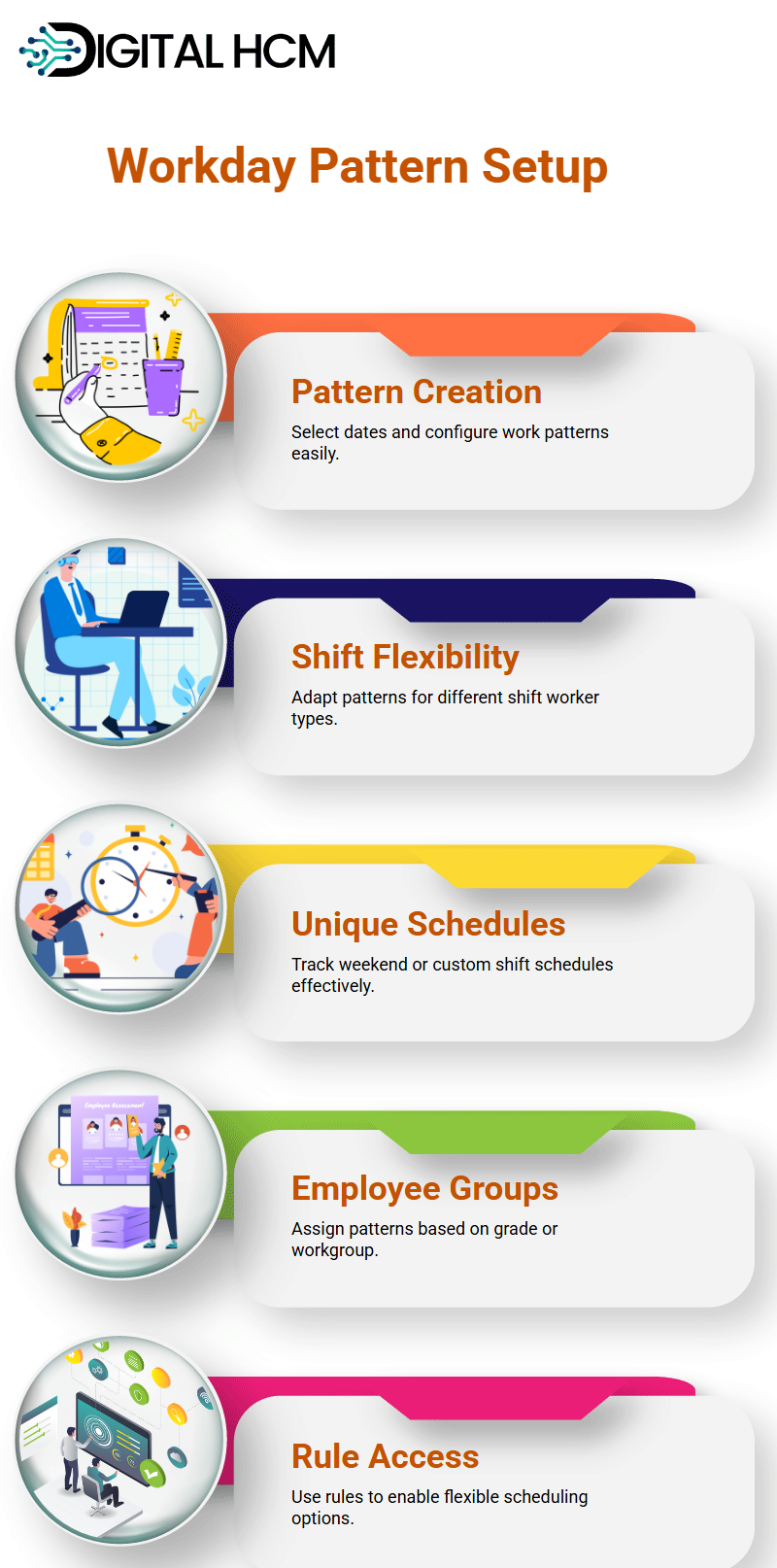
Setting Up Workday Time Tracking Calendars
To set up Workday Time Tracking calendars in New York City, New York, USA, the first step should be choosing a schedule that corresponds with local regulations, if applicable.
Workday Time Tracking allows for the efficient management of multiple calendars across one nation or multiple groups, seamlessly.
Once an employee creates their calendar with Workday Time Tracking, various details like the work start date can be set.
Assuming Sunday is set as the first day of each week, setting this schedule can allow a configurable calculation period for weekly transitions and is straightforward, similar to creating a work schedule.
Managing Work Patterns with Workday Time Tracking
With Workday Time Tracking’s tools for time tracking and creating work patterns for various groups of employees, Workday provides ways of controlling working practices with Workplace Time Tracking.
If you’re in New York City, USA, you’ll find that no matter if it is for shift workers or people with standard schedules, creating patterns can be done easily and effortlessly. Just select a tenant and enter their start date.
Once done, patterns can then easily be configured based on those rules and the needs of individuals in that group.
Workday Time Tracking gives you the flexibility of customising the working hours for every day – for instance, on Monday, this might mean 9 AM to 3 PM; on Tuesday, 10 AM to 5 PM, etc.
This flexibility enables you to meet individual employees’ unique requirements while simultaneously providing accurate time tracking, making it an ideal solution for businesses in the bustling environment of New York City.
Workday Time Tracking to Increase Efficiency
By now, you may have become adept at using Workday Time Tracking, especially if you’re participating in the Workday Time Tracking Tutorial in New York City, USA.
Not only is this service about managing hours; rather, it allows your workforce to adapt according to changing demands.
Workday Time Tracking makes ensuring employee work patterns align with organisation requirements easier for managers of shift workers or regular employees alike, by simplifying scheduling and time tracking processes.
So, dive right in and discover all that Workday Time Tracking can offer, using its user-friendly tools and powerful insights.
Working Patterns in Workday Time Tracking
To maximise efficiency when managing work patterns, let’s use Workday Time Tracking’s configuration features for creating work patterns to suit daily operations, especially in a bustling environment like Workday Time Tracking Tutorial in New York City, New York, USA.
By configuring patterns based on workday operations, you can quickly make use of Workday Time Tracking as you add specific patterns that align with each of them.
Start by choosing your pattern’s start date and time. Additionally, this system offers the capability to add working days by simply clicking a plus icon, giving you complete flexibility over when and how many working hours take place each week.
Workday Time Tracking makes scheduling consistent a breeze with its auto-calculating feature that uses your inputs to automatically determine hours for you, helping maintain consistency across schedules.
This feature makes maintaining consistency between schedules incredibly effortless, which is particularly valuable for organisations operating in dynamic locations like New York City.
Enhancing Work Schedules
With Workday Time Tracking, you can effortlessly capture all the working patterns and hours for your team. Set different daily work shifts, such as 9 AM to 7 PM on Monday or 10 AM to 7 PM on Tuesday, etc.
Once these details have been inputted into Workday Time Tracking, its platform ensures a structured yet manageable schedule for you and your colleagues to follow. With such a versatile solution suitable for varying organisational needs, Workday Time Tracking is an ideal solution.
No matter if it is a weekly, biweekly or monthly transition, Workshares in Workday Time Tracking can easily adapt to meet specific requirements with ease.
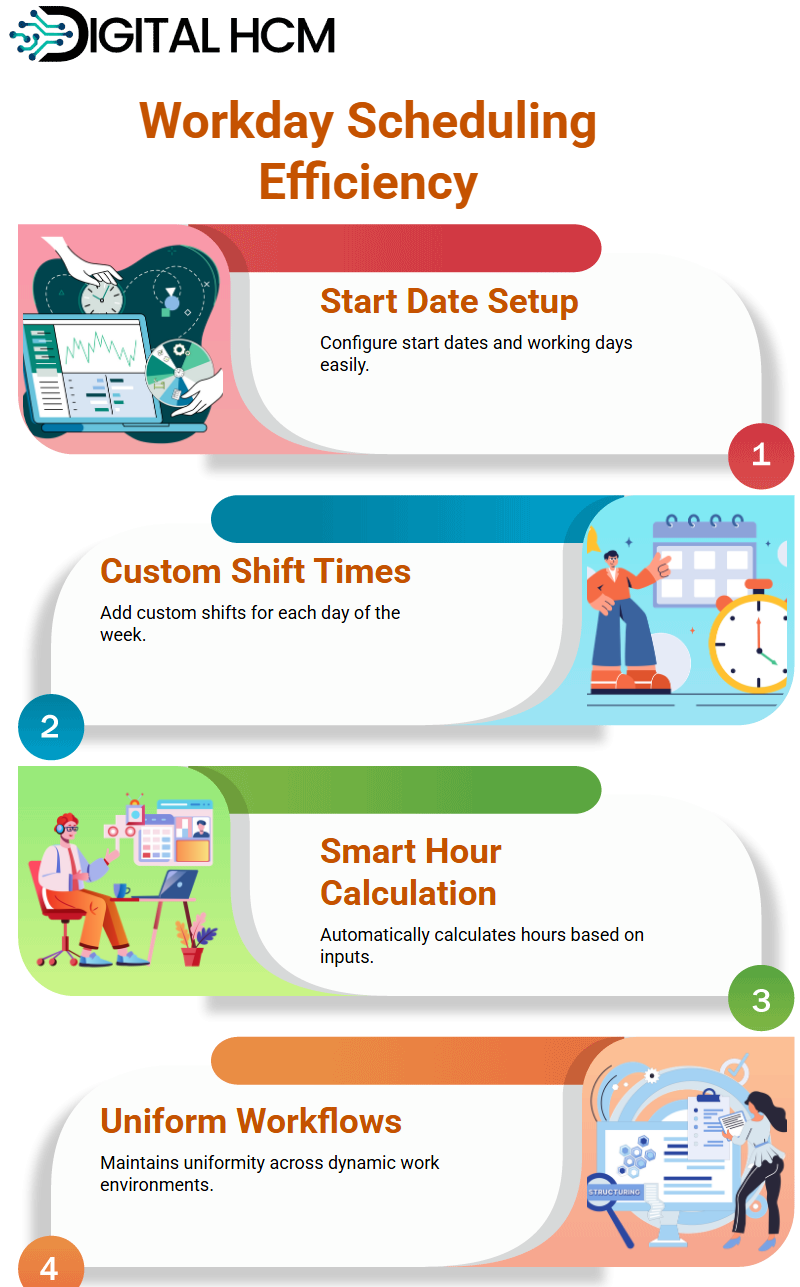
Workshare with Workday Time Tracking
Workday Time Tracking’s Workshare feature provides a valuable benefit by allowing users to efficiently organise multiple calendars into a shared workspace for scheduling.
Once this shared workspace is created, users can easily download any necessary information or manage everything from this central hub.
It offers unmatched control over work schedules and patterns, saving time by consolidating calendars for easier tracking of work hours.
Workday Time Tracking Tutorial in New York City, USA, can help improve time tracking accuracy by guiding users on how to establish patterns within the system.
Setting Up Patterns in Workday Time Tracking
Workday Time Tracking allows for greater flexibility when setting work schedules. If your needs require something different, simply modify start and end times accordingly.
In this Workday Time Tracking tutorial in New York City, USA, setting Monday work hours of 9 AM to 6 PM is easy: just use its settings page, add in those hours of work, and watch as the system automatically calculates total weekly hours worked.
Workers may follow different schedules based on company needs; for instance, some might follow an 8 am-6 pm or rotating shift pattern, while others could need more flexible arrangements, such as 9-5 work.
With Workday Time Tracking’s seamless management tools, all variations can be managed effectively and smoothly.
Workday Time Tracking Enhances Workforce Scheduling
Shift schedules are no simple feat, but Workday Time Tracking makes this easier with its time tracking functionality.
From flexible working hours to fixed shifts and everything in between – everything can be set up within seconds using Workday Time Tracking’s intuitive user interface.
Once their schedules have been configured, employees will gain clear insight into their assigned work hours.
Workday Time Tracking ensures accuracy by recording regular patterns of work, overtime policies, and shift adjustments accurately.
Workday Time Tracking makes workforce planning simpler for businesses by streamlining employee work patterns without creating confusion over scheduling arrangements and improving operational efficiencies.
Businesses using Workday Time Tracking to effectively structure workforce planning can improve operational efficiencies without creating scheduling mishmashes that obstruct employee work patterns, making time tracking even more essential to daily business life.
With Workday Time Tracking, Employee Schedules Can Become Clear and Seamless. For those interested in a Workday Time Tracking tutorial in New York City, New York, USA, it’s a great opportunity to learn how to make the most of this powerful tool.
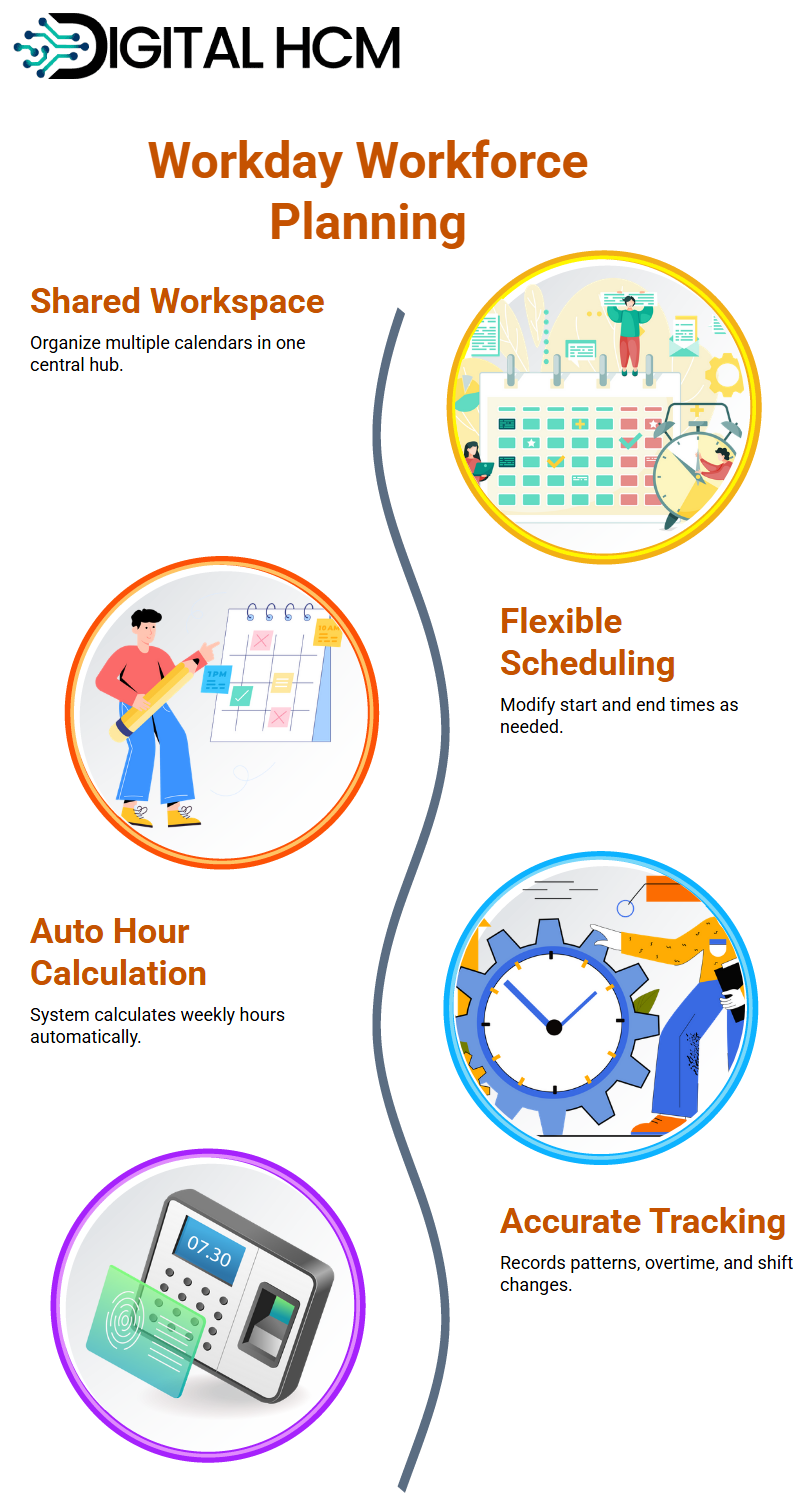
Employee Work Schedules Using Workday Time Tracking
Want to adapt existing schedules? Workday Time Tracking makes this task straightforward with its user-friendly interface for changing employee work patterns.
Whether in a bustling location or anywhere else, Workday Time Tracking makes it simple to update shift patterns as they change, providing real-time adjustments of settings without disrupting employee schedules or alteration requests.
Workday Time Tracking ensures every worker has an efficient schedule, be it altering shift lengths or work patterns; its process is smooth and hassle-free.
Workday Time Tracking’s Buffer Creation feature makes creating buffers simpler than ever. For guidance on setup and usage, a Workday Time Tracking tutorial in New York City, USA, can provide valuable insights and step-by-step help.
Creating Buffers with Workday Time Tracking
Workday Time Tracking goes beyond simply tracking restrictions; it also serves to create buffers in your work life. From enterprise projects to individual components, this tool gives you more room to create flexibility into your schedules.
Imagine having the freedom to adjust work patterns or add dynamic features like calendar events without disrupting structure – that’s the power Workday Time Tracking gives you.
Calendar Events in Workday Time Tracking
Workday Time Tracking’s calendar feature is another game-changer, offering dynamic features like creating multiple calendar events across any day, week, or month with just the touch of a button – plus it handles one-time or recurrent events effortlessly.
Start creating events today – Workday can manage both repetitive events as well as one-off ones easily.
If you’re in New York City, USA, our tutorial will guide you through the process of utilising these features effectively.
Workday Time Tracking makes scheduling less complex by tracking employees based on their schedules, helping you never miss a beat.
Our Time Tracking feature has also proven invaluable when grouping employees by their shift schedules, keeping employees productive throughout their shift.
Workday Time Tracking makes it simple and effective for anyone working internationally to manage the time zones and workdays across their organisation, increasing efficiency and productivity across the board.
Its dynamic capabilities adapt perfectly to various organisational requirements, ensuring that maximum efficiency and productivity are realised at every turn.
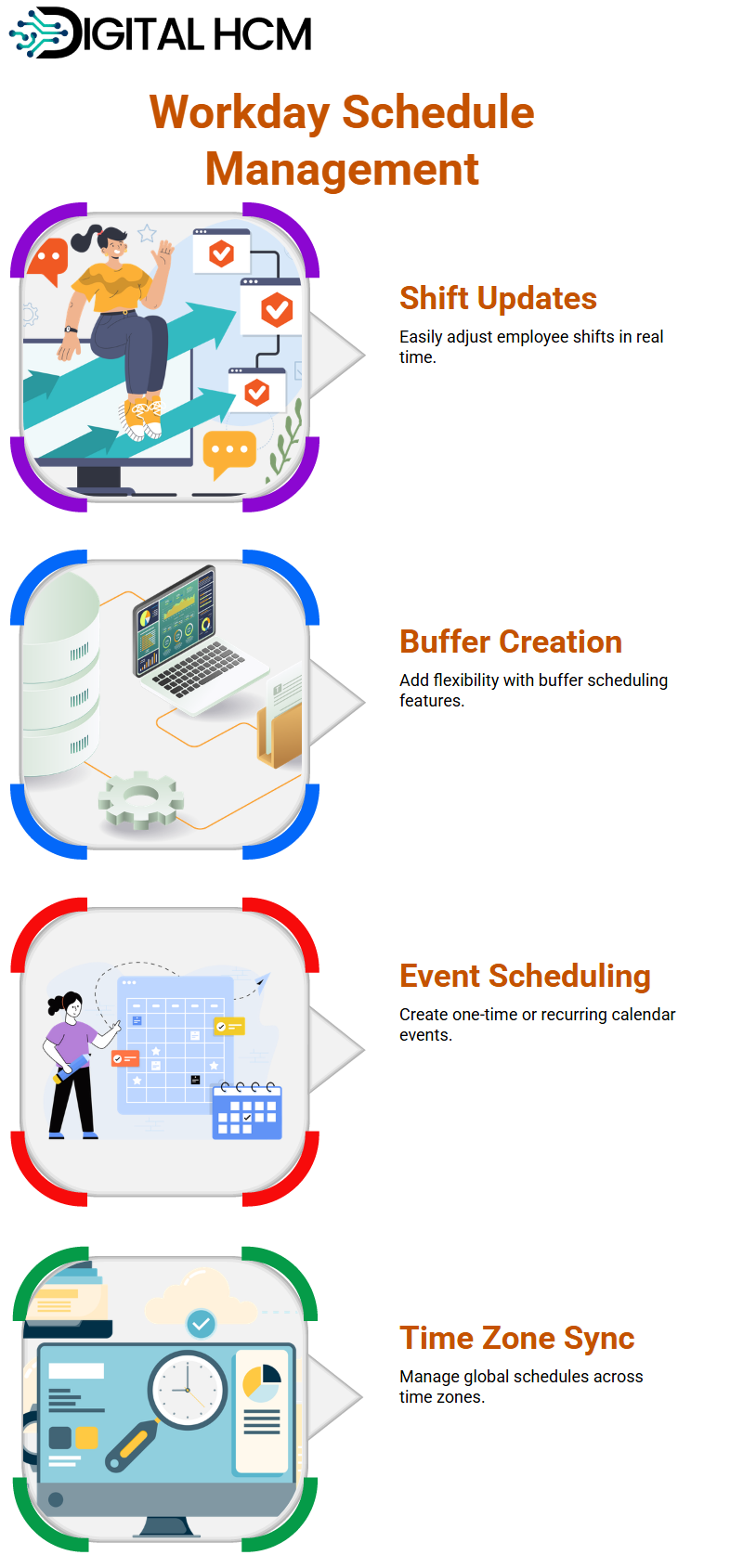
Workday Time Tracking Patterns
Do You Wonder How to Efficiently Manage Work Schedules? Let’s investigate Workday Time Tracking to understand its role in streamlining scheduling processes for workers.
Starting by learning the fundamentals of creating and applying Workday Time Tracking patterns effectively in real-world scenarios is the first step to success.
Once in your tenant area, view existing Workday Time Tracking patterns, then identify an initial start date you wish to apply across eligible workers.
Say you are transitioning into weekly working patterns: To set it in motion, start by choosing your starting date and marking Sunday as the office holiday day.
Once this date has been defined, look out for the plus sign; clicking it allows you to add working dates and start times.
Workday Time Tracking makes arranging workday schedules simple with its flexible feature set; Monday may involve 9 AM-7 PM hours, while Tuesday might see 10 AM-7 PM shifts. Workday Time Tracking’s customisability ensures smooth implementation for workers.
Customising Work Schedules with Workday Time Tracking
Workday Time Tracking makes customising schedules simple yet dynamic; simply click to modify existing patterns if you desire a different pattern or create one! If desired.
Workday Time Tracking allows you to define customised schedules for various groups.
Say you employ someone whose regular hours span 9 AM-6 PM; with Workday Time Tracking’s flexibility, it allows for these times to be altered according to individual needs and circumstances.
Furthermore, Workday Time Tracking excels when accommodating shift workers because its software supports their multiple patterns of shift work.
The system supports up to 242 patterns, making it an efficient way of managing various workgroups. You can assign patterns based on employees’ shift schedules or requirements with just a few clicks of your mouse.
Real-Time Applications of Workday Time Tracking
In real-time, Workday Time Tracking facilitates effortless cloning and implementation of patterns with its EAB (Enterprise Application Builder). EAB’s efficient replication saves both time and resources when managing large groups of workers.
Let’s say you need to apply Workday Time Tracking across 62 patterns at once, with its intuitive user interface making viewing and assigning patterns simple. Aligning them with rough schedules ensures every worker’s time is used optimally.
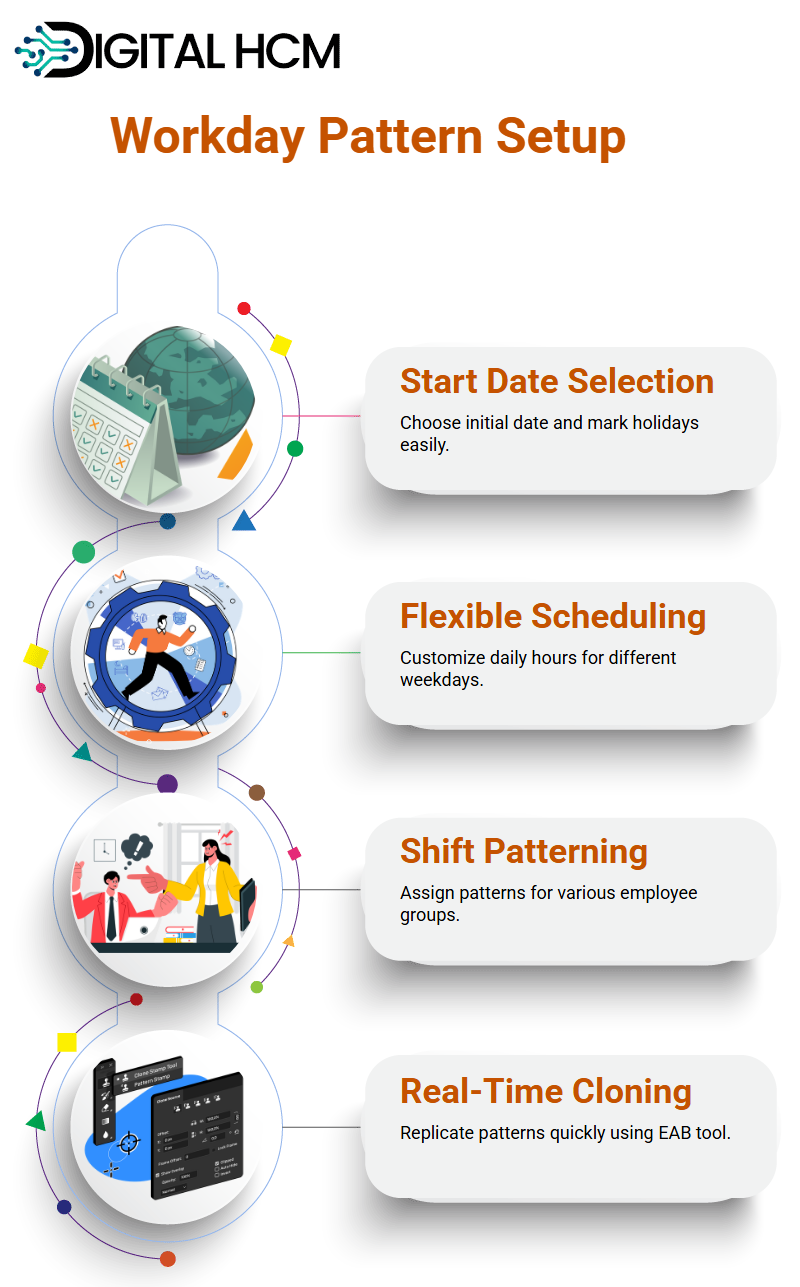
Optimising Work Patterns with Workday Time Tracking
Workday Time Tracking’s adaptability makes it ideal for optimising work patterns; whether regular salaried employees or contractors with flexible working arrangements require flexible schedule options, this system has them.
Regular patterns typically run between 9 AM and 6 PM shifts; however, schedules can differ considerably among groups.
Workday Time Tracking gives you the power to create and assign tailored schedules for contractors. For instance, some may work from 2 PM to 3 PM over three days, while others have regular weekly patterns – the tool’s capacity to accommodate such flexibility ensures all group’s scheduling requirements are efficiently met. WTT Features
Workday Time Tracking Features
Take an in-depth dive into Workday Time Tracking’s wonderful world: it makes managing schedules effortless with its calendar view/edit features.
And that is only part of its benefits; its flexibility also enables time tracking to fit seamlessly with modern office life and enhance productivity!
For those interested, a Workday Time Tracking tutorial in New York City, New York, USA, can provide further insights into its capabilities.
Workday Time Tracking presents workers’ schedules in an easy-to-read calendar format. A regular pattern, such as 40 hours per week, can easily be set up.
Utilising this tool ensures employees manage their work schedules more consistently and efficiently while increasing the consistency and efficiency of employee management practices. Our Patterns & Schedules service utilises this same technology.
Workday Time Tracking for Patterns and Schedules
Workday Time Tracking stands out by accommodating unique work patterns.
No matter if your working environment is office-based or industrial manufacturing, this system helps create and organise an organised work schedule, such as having to ensure 5 hours of work is accomplished daily.
Workday Time Tracking makes time tracking simple so that production workers, or those with strict time requirements, can focus on what matters.
Restrictions such as minimum hours, maximum hours, and start/end times can all be added quickly for production workers or those whose schedule requires strict time requirements.
With Workday Time Tracking, keep everything organised so you can concentrate on what matters.
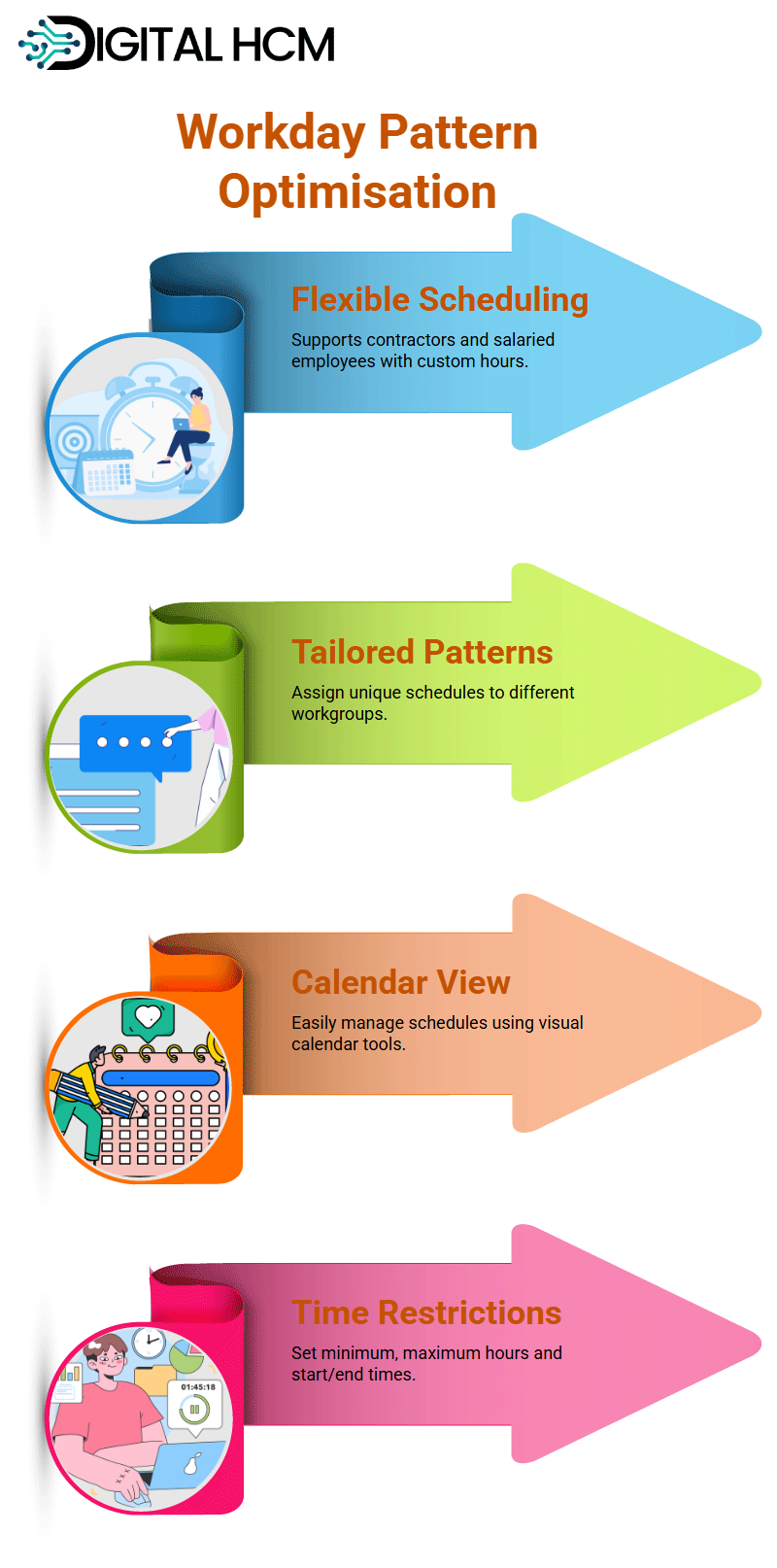
Editing Work Patterns with Workday Time Tracking
Workday Time Tracking allows workers to make necessary modifications to their schedules easily, such as changing start times. While keeping the overall structure intact, Workday Time Tracking makes such changes seamless for users.
Let’s say you need to add 15 minutes before starting work – Workday Time Tracking makes this effortless.
Built specifically to adapt to real-world scenarios and ensure schedules remain flexible as your workforce changes over time, Workday Time Tracking ensures schedules reflect this effectively.
Flexibility of Workday Time Tracking Calendars
Workday Time Tracking Calendars have multiple countries or teams that you need to manage calendars across? No worries: Workday Time Tracking provides customisable options that meet a range of requirements.
Weekly transitions, custom patterns and work schedules are just part of its comprehensive set of features. For instance, you could set Sunday as the beginning of each workweek or define specific calculation periods to customise calculations to specific time intervals.
Workday Time Tracking allows you to efficiently generate schedules tailored precisely to the requirements of your organisation.
Setting Up Workday Time Tracking Patterns
When configuring work patterns in Workday Time Tracking, start by choosing when it should begin for eligible workers and click Set Up Patterns for best results.
After choosing your start date, use the plus sign to set additional working dates with their start times. Simply click it once per working day you would like added.
Workday Time Tracking will automatically calculate hours based on any start dates or start times entered; patterns can span different days and times of day, such as 10 AM on one day and continuing at various other start times during other days, giving flexibility for you to define and refine these patterns with ease.
Weekly and Daily Patterns of Workday Time Tracking
Weekly and Daily Patterns One of the great aspects of Workday Time Tracking’s unique value lies in its flexibility: whether it is setting patterns daily or weekly, this system adapts itself perfectly.
You could create patterns from 9 AM to 6 PM daily, or define multiple shift worker patterns to meet various operational requirements.
Imagine an office where each department follows distinct patterns for working hours tracking.
Workday Time Tracking makes this easy by creating as many patterns as necessary per period schedule to account accurately for employees’ working hours while keeping operations smooth and running efficiently.
Workday Time Tracking allows you to efficiently organise all these possibilities, whether starting with regular 9 AM-6 PM shifts for regular workers, or more complex patterns where workers follow various schedules.
There’s truly no end to what could be managed through its intuitive software! The possibilities are truly limitless.
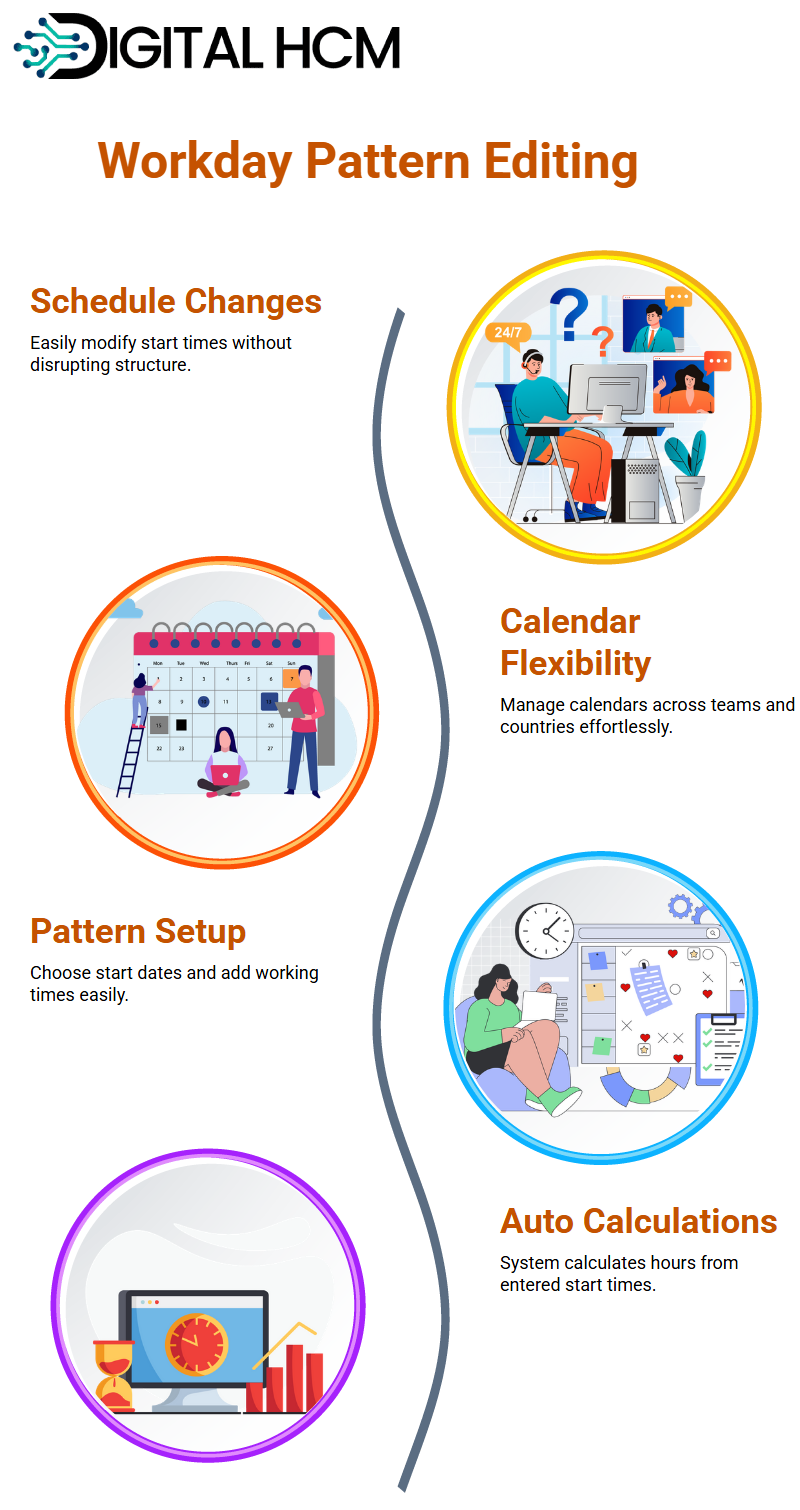
Workday Time Tracking Calendar Configuration Tips
Now let’s discuss configuring calendars in Workday Time Tracking. When naming calendars to reflect their purpose or region, such as “Canada Workforce Schedule”, for instance, this helps reduce confusion and organise data efficiently.
Once the calendar is created, enter details such as work start date and configuration in Workday Time Tracking to ensure accurate capture. Without leaving room for error.
Workday Time Tracking allows you to assign specific patterns or schedules to an entire group with ease and create options tailored specifically for their needs.
No matter whether it is weekly transitions or daily configuration, this tool has you covered. Make adjustments on the fly to ensure your workforce operates efficiently.

James

Success in your career comes from curiosity, courage, and consistency. Stay committed, stay curious and never stop learning.
